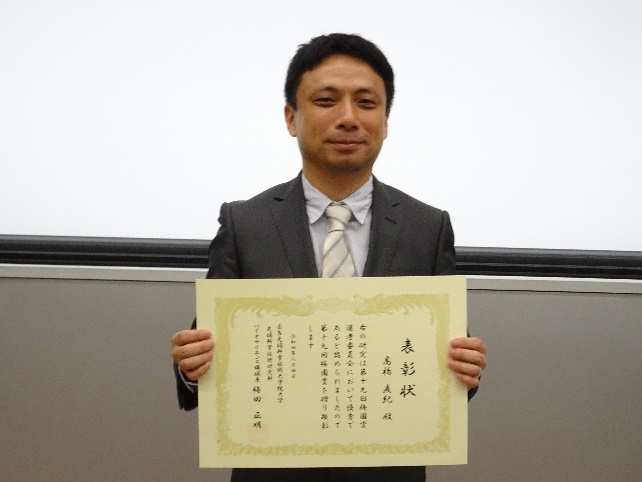第19回梅園賞授賞式が開催されました。
バイオサイエンス領域 植物成長制御研究室の髙橋直紀助教と、分子医学細胞生物学研究室の西村珠子助教が第19回梅園賞を受賞しました。
8月4日に、Rethinkバイオサイエンス領域大講義室(L11)にて授賞式と記念講演が行われ、多くの教職員と学生が参加し、受賞者の功績を称えました。
梅園賞は、梅園基金の設立趣旨に沿って、熱気溢れる時期にバイオサイエンス研究に精進し、バイオサイエンス領域において優れた研究成果(論文発表)をあげた本学の助教あるいはポスドク研究員の原則1 名を顕彰するものです。過去において助教あるいはポスドクとして本学に在籍していた方も選考の対象としてします。対象者が研究の推進に中心的な役割を果たしたと認められる発表論文(2020年6月1日〜2022年5月31日の期間に査読付き国際学術誌に発表されたもの)の学術的価値とオリジナリティの高さに審査の重点が置かれています。受賞者には表彰状と副賞が授与されました。


第19回梅園賞受賞者 髙橋直紀助教のコメント
 この度は、梅園賞という栄えある賞を授与していただき、誠に有難うございます。大変光栄に思うと同時に、身の引き締まる思いです。受賞の対象となった論文は、奈良先端大で助教に就任してから始めた研究になります。論文にまとめるに至るまでは長い時間がかかりましたが、その間も継続的にサポートして下さった梅田正明教授ならびに、研究室のメンバー、共同研究者の先生方には深く感謝申し上げます。この名誉ある梅園賞を励みに、より一層研究に精進して参ります。
この度は、梅園賞という栄えある賞を授与していただき、誠に有難うございます。大変光栄に思うと同時に、身の引き締まる思いです。受賞の対象となった論文は、奈良先端大で助教に就任してから始めた研究になります。論文にまとめるに至るまでは長い時間がかかりましたが、その間も継続的にサポートして下さった梅田正明教授ならびに、研究室のメンバー、共同研究者の先生方には深く感謝申し上げます。この名誉ある梅園賞を励みに、より一層研究に精進して参ります。
髙橋直紀助教の受賞研究の発表内容(演題と要旨)
DNA損傷応答における植物ホルモンのサイトカイニン、オーキシンの役割
Cytokinin and auxin orchestrate distinct DNA damage responses in roots
Abstract:
Maintenance of genome integrity is crucial for proper growth and development. Eukaryotic cells deploy the mechanism of DNA damage checkpoint, which ensures DNA repair by arresting the cell cycle and provokes cell death to eliminate genetically damaged cells. In plants, to strike a balance between genome maintenance and organ development, plants trigger distinct DNA damage responses according to cell types in tissues. It has been shown that in Arabidopsis roots, DNA double-strand breaks (DSBs) indue cell cycle arrest at the G2 phase in the root tip, cell death in stem cells, and an early transition from cell division to endoreplication in the basal part of the root apex. These responses replenish stem cells and reduce the number of meristematic cells, thereby contributing to the maintenance of genome integrity and enabling continuous root growth. However, the mechanisms that govern these distinct DNA damage responses in a spatiotemporal manner have remained unknown. We revealed that DSBs enhance biosynthesis of the plant hormone cytokinin through the DNA damage signaling pathway, and inhibit the downward flow of another hormone, auxin, in Arabidopsis roots. The resultant decrease in the auxin level induces cell cycle arrest at G2 phase and stem cell death, whereas elevated cytokinin signals in the basal part of the root apex promote an early onset of endoreplication. These findings show that combinatorial control of plant hormones coordinates distinct DNA damage responses, thereby maintaining genome integrity and eliminating damaged stem cells to ensure sustainable root growth.
第19回梅園賞受賞者 西村珠子助教のコメント
 この度は、このような素晴らしい賞を頂きまして、誠にありがとうございます。今回私たちが分泌機構を見出した細胞突起由来の細胞外小胞は、発生、免疫等における様々な細胞間情報伝達や、がん等の疾患形成に関与すると考えられ、今後更なる発展が期待される分野です。ご指導を頂きました末次志郎先生、一緒に研究を進めてくれました卒業生の大山拓也さん、在学生のHu Hooi Tingさんと藤岡敏史さん、共同研究を行って下さった先生方、そして末次研究室の皆様に、厚く御礼を申し上げます。
この度は、このような素晴らしい賞を頂きまして、誠にありがとうございます。今回私たちが分泌機構を見出した細胞突起由来の細胞外小胞は、発生、免疫等における様々な細胞間情報伝達や、がん等の疾患形成に関与すると考えられ、今後更なる発展が期待される分野です。ご指導を頂きました末次志郎先生、一緒に研究を進めてくれました卒業生の大山拓也さん、在学生のHu Hooi Tingさんと藤岡敏史さん、共同研究を行って下さった先生方、そして末次研究室の皆様に、厚く御礼を申し上げます。
西村珠子助教の受賞研究の発表内容(演題と要旨)
フィロポディア切断により形成される新たな細胞外小胞の発見
Discovery of the novel extracellular vesicles from filopodia
Abstract:
Extracellular vesicles (EVs) are small membrane vesicles that are secreted from cells and contain various molecules, including proteins, miRNAs, and mRNAs. EVs stimulate the recipient cells in the vicinity of the producing cells or in the tissues that locate distantly by traveling in the body fluids. Particularly, EVs are shown to play significant roles in morphogenesis, immune cell activation, and stemness of pluripotent cells. EVs are also involved in various diseases, such as cancer and neurodegenerative disease. EVs from cancer cells sometimes promote cell proliferation, invasion, angiogenesis, and metastasis.
EVs from living cells are classified largely into 2 categories, one is endosome-derived EVs, and the other is plasma membrane-derived EVs. The endosome-derived EVs are often referred to as exosomes and have been extensively studied. In contrast, there are limited studies on the biogenesis and physiological roles of plasma membrane-derived EVs.
We recently found that the I-BAR protein MIM, which deforms the plasma membrane for protrusions of filopodia, is involved in the EV biogenesis. The filopodia having MIM were found to be more fragile and can be a source of EVs. Moreover, MIM-dependent EVs were found to enhance the migration of the recipient cells, including cancer cells.
Therefore, the EVs produced from the I-BAR protein-induced filopodia are novel signal-transducing vesicles that carry the molecules on the filopodia, by directly transmitting them to the recipient cells to modulate their behaviors.
(2022年08月05日掲載)
 奈良先端科学技術大学院大学
奈良先端科学技術大学院大学